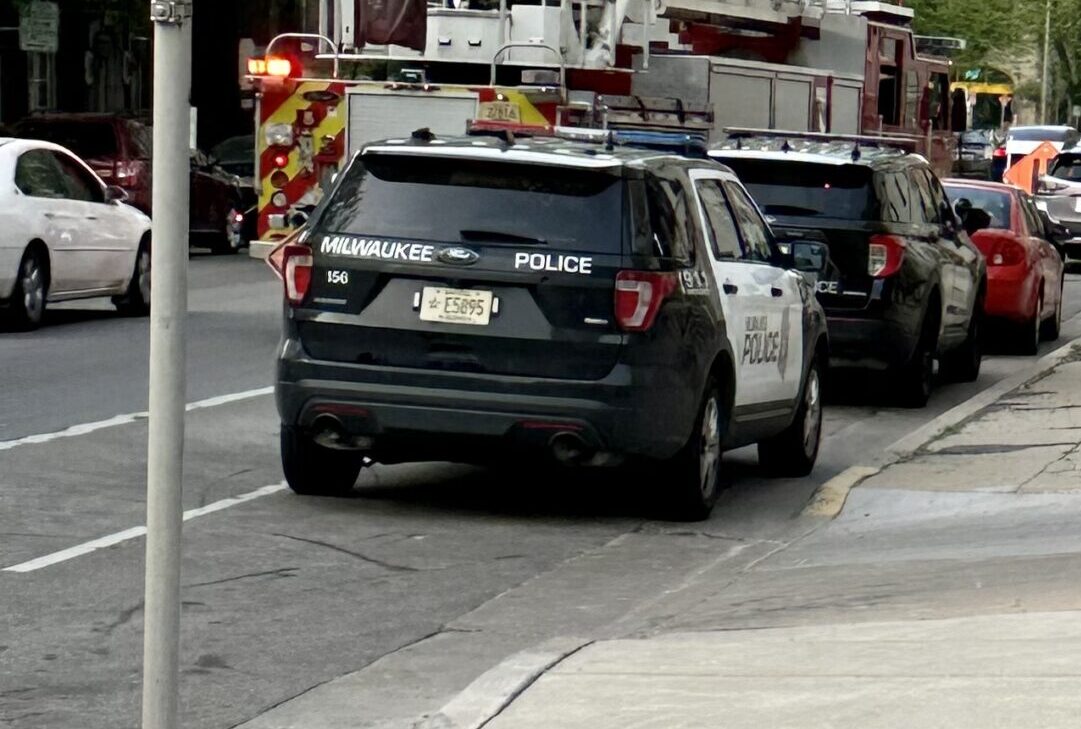Shanghai to Madison
By: dmc-admin//July 26, 2006//
 |
| Twenty visiting judges from Shanghai have a rare opportunity to take the Supreme Court bench during a tour at the state Capitol.
Photo by Jack Zemlicka |
Picture a perfectly square room layered with marble from four countries, century-old mahogany furniture and detailed murals, housed in perhaps the most recognizable building in Wisconsin.
The Wisconsin State Supreme Court inside the state Capitol was the perfect location for a select group of judges from Shanghai, China, to begin their study of the American courts system. That journey began on July 17.
After several months of intense English-language training and testing, 20 carefully selected Shanghai judges became the 2006 class of the Fourth Annual Seminar on Judicial Skills Development, an honor which included a three-week stay in Madison.
The program is a joint venture of the Shanghai People’s Court and the University of Wisconsin’s East Asian Legal Studies Center, in close conjunction with the state and federal judiciary.
Designed to enhance understanding of foreign judicial systems, the initiative has grown into a solid partnership between the United States and China and afforded representatives the opportunity to travel abroad.
“This program has been excellent,” stated Shirley S. Abrahamson, chief justice of the Wisconsin Supreme Court who spoke to the judges during their visit to the Capitol. “It’s important for Shanghai judges to learn about different court systems, but it’s also important for our judges to learn about different court systems.”
|
Dane County judge helps prepare Chinese judges Diane Nicks anticipated her recent business trip would be stimulating, but she didn’t expect it to be life-changing. The Dane County Circuit Court Judge was selected to participate in the 2006 Seminar on Judicial Skills Development, a four-week program which began with a seven-day visit to Shanghai, China, in June. Nicks, along with program veterans, John Ohnesorge, assistant professor of law at the University of Wisconsin Law School, and Gail Ibele, English as a second language teacher at UW-Madison, made the trip to acquaint themselves with 20 Shanghai judges chosen for this year’s seminar. The trio’s purpose was to familiarize themselves with the Chinese judges in their native environment and help prepare them for a three-week visit to Madison in July. In its fourth year, the cooperative effort by the Shanghai High People’s Court and the University of Wisconsin’s East Asian Legal Studies Center in conjunction with the state and federal judiciary, has thrived on overwhelming support. “In each of the years, a different Dane County Judge has had the opportunity to go to China and teach for a week,” explained Shirley S. Abrahamson, chief justice of the Wisconsin Supreme Court. “The interest, not only in Dane County, but from surrounding judges and in China, has been amazing.” Abrahamson has toured Shanghai, as have both Ohnesorge and Ibele, but it was the first visit for Nicks who was immediately overwhelmed. “Right when we got off the plane, we were greeted by members of the High Court and I think I had some semblance of what an ambassador felt like,” said Nicks. Also at the airport were three judges from past years, an added surprise for Nicks who had worked with each of them during their time in Madison. “Certainly relationships have been built and sustained over the years and it was wonderful to have the opportunity to see them again,” said Nicks. “We spent a tremendous amount of time together during the program and strong bonds formed.” The three visitors were welcomed with an elaborate ceremony in the judicial college hall which Nick’s likened to something out of a fairytale. “I had no idea what to expect, but the scene was something you picture out of a storybook, said Nicks. “I was put incredibly at ease the first night and while things were still very formal, they felt very comfortable.” The accommodating atmosphere made the transition from the ballroom to the classroom a smooth one. The trio prepared discussions on the U.S. judicial system and topics like jury selection and law trends, though Nicks ultimately found the format to be unexpectedly lecture intensive. “I was surprised with how little discussion took place in the classroom, but also at how attentive the judges were,” said Nicks. “I was informed that they are used to straight lectures for the most part and it was something a little different for me.” The majority of questions routinely arose in a more informal setting designed to maximize the Shanghai judges’ English-speaking skills. “Each night, two or three judges would eat dinner with us and we would talk about everything from courtroom procedures to favorite movies,” said Nicks. “I was amazed at some of the stories the judges would tell; legends and unique historical perspectives. It was enthralling.” As cerebrally engaging as the conversations were, the aesthetic appeal of the area was equally captivating to the senses according to Nicks. “Our residence was set away from Shanghai and it was like a fantasyland,” said Nicks. “In the city, the development was unbelievable. I could never have spent enough time there to see everything.” – Jack Zemlicka |
With about 3,000 active judges in Shanghai, the decision to determine which would participate in this year’s program was a difficult one according to Charles R. Irish, Director of the East Asian Legal Studies Center at the University of Wisconsin Law School.
“I think the senior judges, many of whom are not law trained or proficient in English, serve in supervisory capacities to nominate the younger judges who show promise as judges and as representatives of China,” stated Irish. “There is an initial selection of 40 and then 20 are carefully selected by the senior judges in Shanghai.
Participating in this program is a plum, so there is certainly haggling among the decision-makers.”
Prior to their visit, a trio of Wisconsin representatives traveled to Shanghai in June for a week-long orientation with the judges. Program veterans John Ohnesorge, assistant professor of law at the UW and Gail Ebele, English as a second language instructor at UW, along with Dane County Circuit Court Judge Diane Nicks helped prepare the Chinese judges with lectures and discussions on the U.S. courts.
The rigorous preparation entered phase two when the 20 judges touched down in Wisconsin and began their acclimation to American culture.
“We are very excited to be here and when we arrived, the blue sky, white clouds and green grass impressed us very much,” said group leader Huang Xiangqing, chief judge of the Second Criminal Division in Shanghai’s High People’s Court. “It’s a very pretty city.”
During their stay, the judges will enjoy a trip to the Dane County Farmers’ Market, an evening at Concert on the Square and a trip to Minnesota where they will take in a Major League Baseball game. But they will primarily be involved in judicial tours and discussions.
Several local judges and professors will conduct trips to the Dane County Circuit Courts and lecture on the topics of judicial ethics, intellectual property and drug treatment.
Despite vast cultural, political and judicial differences, Xiangqing, who like the majority of the visiting judges specializes in criminal law, anticipated a valuable experience.
“I am, like all the judges interested in American law and American culture,” said Xiangqing. “Of course America is the most advanced legal culture in the world; now China is developing its own and we can learn much from other systems.”
Irish was quick to point out that the purpose of the seminar was not to impose, but to inform.
“The idea behind the visit it to demonstrate what we do in terms of our judicial methods and history,” said Irish. “We’re certainly not going in with the mentality that we do it this way, so should you. We simply want to share our concepts and if they can take something away from it, great.”
Chief Justice Abrahamson opened the tutorials with an informal lecture at the Supreme Court on July 17 where she explained the duties of the Supreme Court justices and gave a brief history of Wisconsin law.
“When you have to think about your own system and try to explain it to somebody else, you understand it better,” Abrahamson said afterwards. “You get a fresh look and can see its great strengths and sometimes its weaknesses.”
After the discussion, cameras and smiles were flashed throughout the Supreme Court as the Chinese judges posed on the bench and consulted Abrahamson with individual questions.
“It was a great honor to speak with the chief justice and we have great respect for her and all the judges here,” said Xiangqing.
The feeling was mutual as Abrahamson and Irish applauded the support given to the program.
“The support from the chief justice all the way down is outstanding,” said Irish. “All I’ve ever had to do is make a call to say the judges are coming in and people clear their schedules for three weeks.”
Jack Zemlicka can be reached by email.
Legal News
- Waukesha man sentenced to 30 years for Sex Trafficking
- 12-year-old shot in Milwaukee Wednesday with ‘serious injuries’
- Milwaukee man convicted of laundering proceeds of business email compromise fraud schemes
- Giuliani, Meadows among 18 indicted in Arizona fake electors case
- Some State Bar diversity participants walk away from program
- Wisconsin court issues arrest warrant ‘in error’ for Minocqua Brewing owner
- Iranian nationals charged cyber campaign targeting U.S. Companies
- Facing mostly white juries, are Milwaukee County defendants of color truly judged by their peers?
- Milwaukee Mayor speaks in D.C. Tuesday at White House water summit
- Chicago man sentenced to prison after being caught with ‘Trump Gun’
- FTC bans non-competes
- Gov. Evers seeks applicants for Dane County Circuit Court
WLJ People
- Power 30 Personal Injury Attorneys – Russell Nicolet
- Power 30 Personal Injury Attorneys – Benjamin Nicolet
- Power 30 Personal Injury Attorneys – Dustin T. Woehl
- Power 30 Personal Injury Attorneys – Katherine Metzger
- Power 30 Personal Injury Attorneys – Joseph Ryan
- Power 30 Personal Injury Attorneys – James M. Ryan
- Power 30 Personal Injury Attorneys – Dana Wachs
- Power 30 Personal Injury Attorneys – Mark L. Thomsen
- Power 30 Personal Injury Attorneys – Matthew Lein
- Power 30 Personal Injury Attorneys – Jeffrey A. Pitman
- Power 30 Personal Injury Attorneys – William Pemberton
- Power 30 Personal Injury Attorneys – Howard S. Sicula











